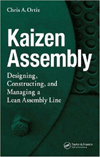The term 5S is derived from five Japanese words that describe a process to organize the workplace. Translations into English vary significantly but, generally speaking, 5S means "a place for everything and everything in its place."
The first-and most important-step toward success with 5S is to get the purpose correct. Failure to do this is endemic and leads to problems of all kinds. The basic principle is that you must know why you want to implement 5S before being concerned about learning how to do it. Most people, when they are asked the purpose of 5S, cite safety, discipline, employee morale, reduced waste of motion and-perhaps the worst reason of all-being tour ready.
All of this is wrong. The true purpose of 5S is to spot problems quickly.
To illustrate, let me share an observation from a visit to Alcatraz island, site of the former federal penitentiary in San Francisco Bay. If you tour the kitchen, you will see a large white board with outlines of all the knives and a hook for each one. In 5S lingo, this is called a shadow board. The purpose of this shadow board was to call immediate attention to the absence of one or more knives.
Before the shadow board, a missing knife usually wasn't detected until it turned up stuck in an inmate. After the shadow board, the problem-a missing knife-was detected with a quick glance before the inmates left the kitchen. Most importantly, the problem was found before anyone was attacked. The same is true in a factory. Get the purpose of 5S right before you start.
The second step toward success with 5S is to continue managing the process after the initial implementation. Sustaining 5S is without question the hardest part. Employees and supporting staff must have all the tools they need to sustain, self-audit and continuously improve the 5S program. The missing element is often the simple requirements of management. If someone doesn't follow a formal policy for safety, doesn't come to work on time, or doesn't do an assigned task as specified, there are consequences. Whether those consequences consist of coaching, discipline or even firing, it is simply not OK to ignore the standards. Why should 5S be any different?
If you invest everyone's time and commitment in 5S, and a few individuals fail to maintain the standard, the program will collapse. I can promise you that the 99 percent of people who are willing to follow the standard will be happy you held the other 1 percent accountable for failing to do so. This isn't mean; it's management.
Many companies feel that they can not go on with lean until they do 5S first. There are valid reasons for this: 5S is visible, simple and gets people's attention. However, you don't have to start there. If you won't get measurable gains from the impact of 5S, perhaps it is not the best starting point. This goes back to knowing why you are applying 5S. If you don't have a compelling reason, don't do it. Furthermore, make sure that everyone knows your purpose-that compelling reason-for 5S. Applying 5S is not a fashion trend-don't do it just because everyone else is.
Whether you agree or disagree, Jamie will welcome your comments. Contact him at jamie@leanlearningcenter.com.





